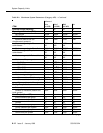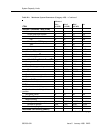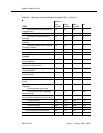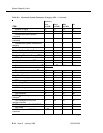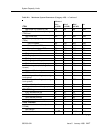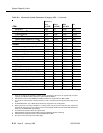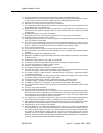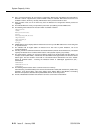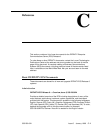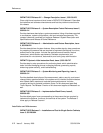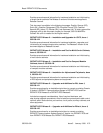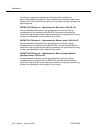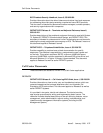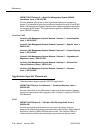
System Capacity Limits
Issue 5 January 1998
B-19555-230-024
10. Number of available 12 character inserted-digit-strings available for AAR/ARS preferences.
11. For Release 6vs, 4 is the recommended number of consoles supported due to power limitations. Of these,
1 may be used as a night console. The software supports 6:1 day/night attendant consoles.
12. This is the same as the number of trunk groups in the system.
13. Referred to as ‘‘emergency access queue length’’ in Release 6si.
14. The monitor split command displays status for the first 100 agents logged into the split regardless of how
many additional agents log into the split.
15. BCMS monitoring is a maintenance command limited by the active maintenance commands limit. It is
reduced by 2 in the r system configuration because 2 active command slots are reserved for the INADS
and SAT logins.
16. Only EPNs in Release 6r can be DS1-remote EPNs.
17. Small systems refer to the 2 carrier cabinet systems that are no longer sold to new customers.
18. Multicarrier cabinet includes the medium Cabinet.
19. 26 bridged appearances (principal + 25) are supported on all R6 platforms, provided that ASAI is not
used. The capacity is 16 with ASAI.
20. The number of call appearances is the sum of primary and bridged appearances; at most 10 can be
primary. A maximum of 54 administrable buttons are supported for the 8434D terminal with expansion
module — 34 buttons in the basic terminal and 20 more buttons in the expansion module.
21. Does not apply to conferencing.
22. The maximum number of users per coverage path equals the number of extensions.
23. Shared extensions must be shared among all attendant groups in the system including tenant partition
scenarios.
24. Measured limits depend on the CMS release used.
25. BRI stations and ASAI are supported on R6.2csi and CMC only with TN556C. The TN2198 is not supported
on R6.2csi or CMC.
26. Simultaneous 3-way conference call = (483 / 3)* number PNs.
27. Simultaneous 6-way conference call = (483 / 6)* number PNs.
28. This feature is introduced in the Release 5.4 load and is not available in previous R5 loads.
29. Login IDs count against the “extensions” switch capacity.
30. These are uniform dialing plan (UDP) entries.
31. The integrated directory entries = stations + attendant consoles.
32. Used for PCOL groups, common shared extensions, access endpoints, administered TSCs, code calling
IDs, LDNs, hunt groups, announcements, and TEGs (phantom extensions).
33. The number of names = number of stations + attendant consoles + trunk groups + digital data endpoints
+ miscellaneous extensions.
34. Hunt group members include non-ACD (hunting, message center service, AUDIX, and so forth) and ACD
uses (splits or skills including auto-available split or skills).
35. The last number dialed entries = stations + digital data endpoints + attendant consoles.
36. Leave WOrd Calling is available in the APB only if the Voice Mail Option is purchased.
37. The MMCH circuit packs can only install in 1 port network per system (PPN or EPN, not both).
38. The actual software limit is 63, but due to performance considerations the recommended number of DCS
nodes is 20.
39. These are node number addresses.
40. G3V2 and G3V3 do not support Tenant Partitioning.
41. Only port slots are included in this count. For example, there are 100 port slots per MCC EPN cabinet with
99 port slots and one slot dedicated to the Tone/Clock board. Other service circuits may further reduce
the number of port slots available. In Release 6r and Release 6si, the service slot may be equipped with
service boards that do not require tip and ring connections.
42. 241 simultaneous circuit-switched calls per port network, except for Release 6si with 180 simultaneous
circuit switched calls and Release 6r with 7,712 (limited by the number of call records supported).
43. R6csi supports PRI D channels over the TDM bus. Each D channel for PRI uses one timeslot pair. An R6csi
with 8 PRIs utilize 8 timeslot pairs, allowing a maximum of 233 simultaneous circuit switched calls.
44. 483 time slots for voice and data per port network.
45. G3V4 and Release 6 use TN744C Call Classifier for basic TTR usage as well as call prompting/call
classification/MFC. Also, the TN2182 Tone/Clock/Detector is used for multiple tone detection functions.
The number of TN748, TN420, or TN744C circuit packs is limited only by the number of available slots.
The number of TN2182 boards is limited. There is a single limit on the total number of tone receiver
(classifier) ports for the system: TN748/TN420 have 4 ports for TTR use, TN748/TN420 have 2 ports for
GPTD use, TN744C has 8 ports for call prompting/call classification/ MFC/TTR/GPTD use, and TN2182 has
8 ports for call prompting/call classification/MFC/ TTR/GPTD use.




